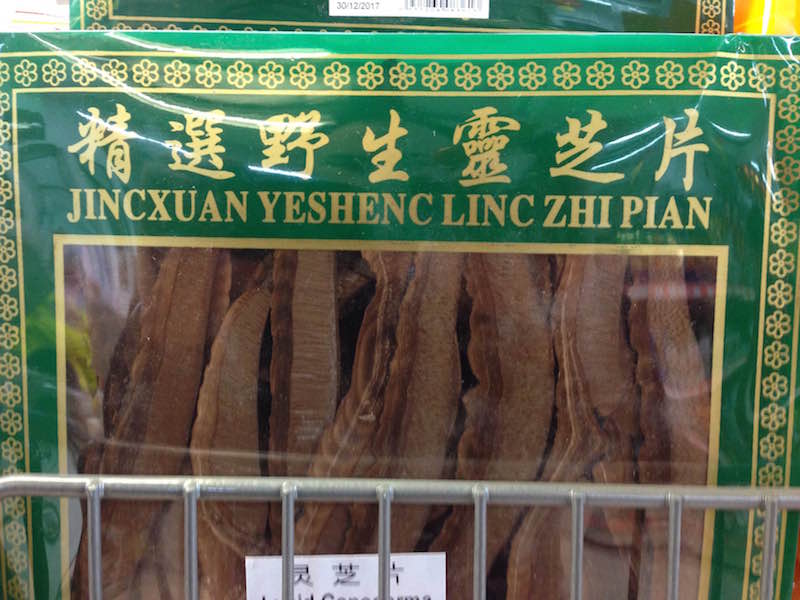Missing G's
« previous post | next post »
Michael Cannings sent in this photograph of a package of shelf mushrooms aka bracket fungi used in Chinese traditional medicine:
jīngxuǎn yěshēng língzhī piàn 精選野生靈芝片
("selected wild Ganoderma slices")
There's nothing much to add except to observe that:
1. all the G's on the package have been turned into C's
2. aside from separating LINC and ZHI, they got the word spacing right
3. although they use traditional characters, as in Taiwan and Hong Kong, the romanization is Hanyu Pinyin, which is the official system in the PRC
I have no good explanation for why they used only CAPS, but this happens quite often in China.

Scott Savitt said,
February 1, 2016 @ 1:30 pm
re: all caps, think nothing more to do with mainland china than a designer's font choice. ALL CAPS stand out more than lower-case words. this is an educated guess based on extensive work with chinese graphic designers. they're also notoriously bad with hanyu pinyin. i think the all-caps would look good, better than lower-case words, if the pinyin weren't misspelled.
Laura Morland said,
February 1, 2016 @ 1:35 pm
I assume it's simply an orthographic "substitution typo," and implies nothing about pronunciation (on anyone's part)?
FM said,
February 1, 2016 @ 2:20 pm
The whole thing is purely a stylistic choice, no? The pinyin doesn't help anyone (or almost anyone) figure out what the product is.
Victor Mair said,
February 1, 2016 @ 3:04 pm
@Laura Morland
Your assumption is correct.
@FM
No. There are still plenty of people in the Sinosphere who are hanzi / character illiterate (despite official statistics claiming unbelievably high levels of literacy [the French economy minister Emmanuel Macron last week said that he doesn't believe Chinese economic data "for a second", and many other economists and social scientists feel the same way about Chinese government statistics]; this is a subject we've discussed many times on Language Log).
Many Taiwanese only learned how to read in Church Romanization.
Many Singaporeans have very low levels of ability to recognize characters, but virtually everybody in Singapore knows the alphabet.
Pinyin is widely used all over China (sometimes alone, even on packaging — I have a large collection of pinyin-only packaging from China in my office and at home).
Pinyin is not just for decoration, if that's what you meant by "The whole thing is purely a stylistic choice…."
Oh, I almost forgot the most obvious reason: there are a lot of foreigners in the Sinosphere who know spoken Mandarin or who know how to read Pinyin, but have little or no ability in reading characters.
Jenny Chu said,
February 1, 2016 @ 8:02 pm
I often see missing G's and extra G's in Romanizations of varying quality when people are uncertain whether the syllable ends with -ng or just n. For example, take a look at the coverage in social after the Tianjin – or was it Tianjing? – explosion last year.
JB said,
February 1, 2016 @ 9:55 pm
I once saw pinyin written right to left, beneath a shop sign which was written that way.
Jenny Chu said,
February 1, 2016 @ 10:05 pm
*social media
Michael Cannings said,
February 2, 2016 @ 4:52 am
This photo was taken in a Chinese supermarket in Liverpool. I think the combination of traditional characters and pinyin can be explained by the mushrooms being grown and packaged in China, but destined for the Hong Kong/overseas Chinese market (where traditional characters predominate).
Joel Wang said,
February 2, 2016 @ 10:05 pm
The product is produced by a town business located in Jiangxi. Some Chinese business owners are ridiculously unconcerned about proper language usage, be it Chinese, pinyin, or English. Partly because they are not well educated, partly because they just don't care.
Rachel said,
February 9, 2016 @ 8:12 am
As for the all caps and Gs becoming Cs, I assume one or a combination of two factors: 1) the fact that, with a Pinyin-based Chinese input system, typing in caps typically enters the text directly as Latin letters rather than calling up the Chinese character candidate menu (and this can be an easier way to enter Latin letters than switching to English mode); and 2) handwritten Latin letters can easily be misinterpreted.
As another example of the latter, I remember very vividly how in Taiwan, many people write their 'r' as barely distinct from a 'v'. I am 99% sure this was the cause for an ad that I saw, otherwise very nicely typeset in both Chinese characters and Latin letters, that promised classes in "Micvosoft Wovd". (Almost like Roman or supposedly-Roman building inscriptions reading "Centvry" or whatever.)